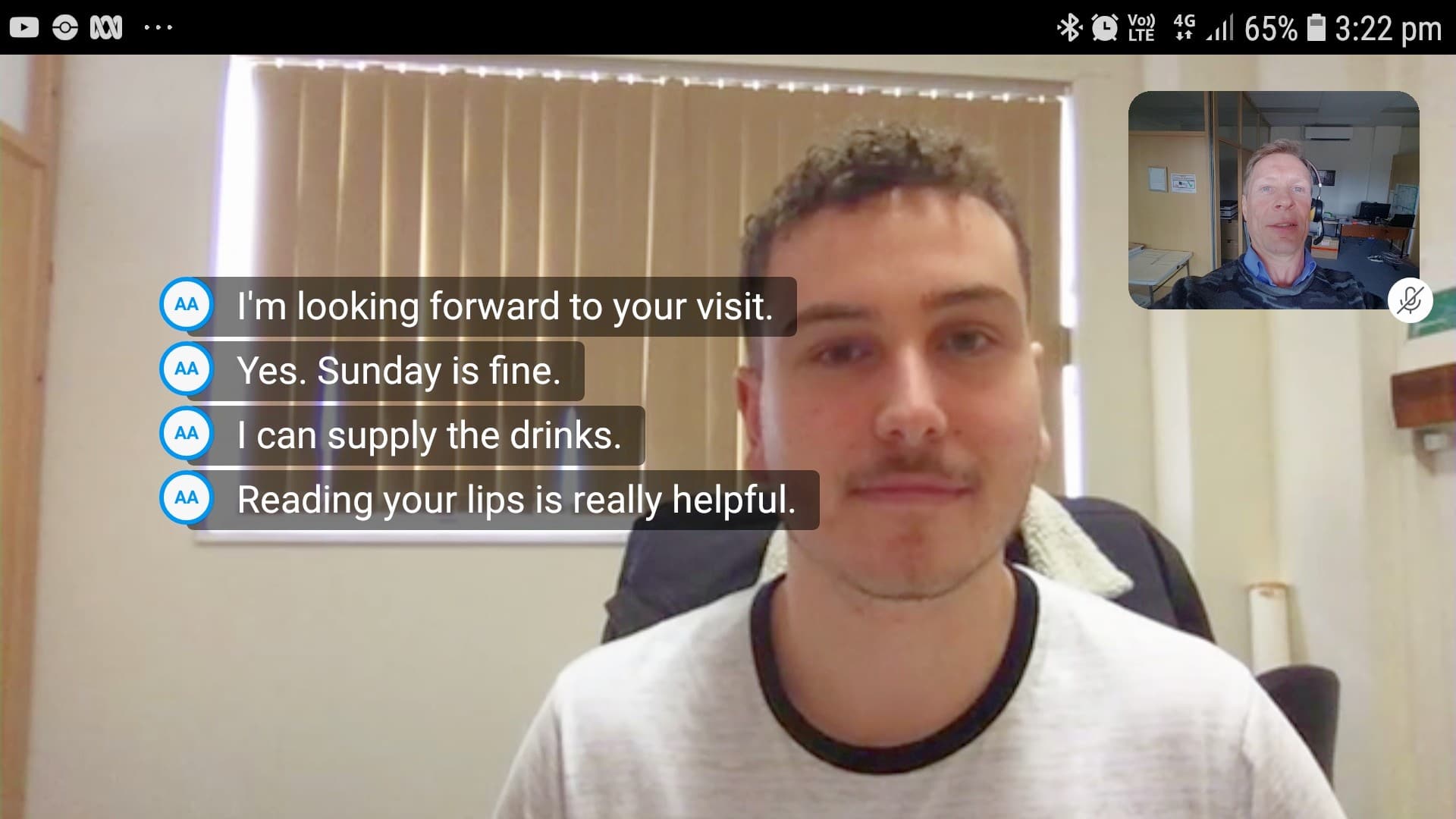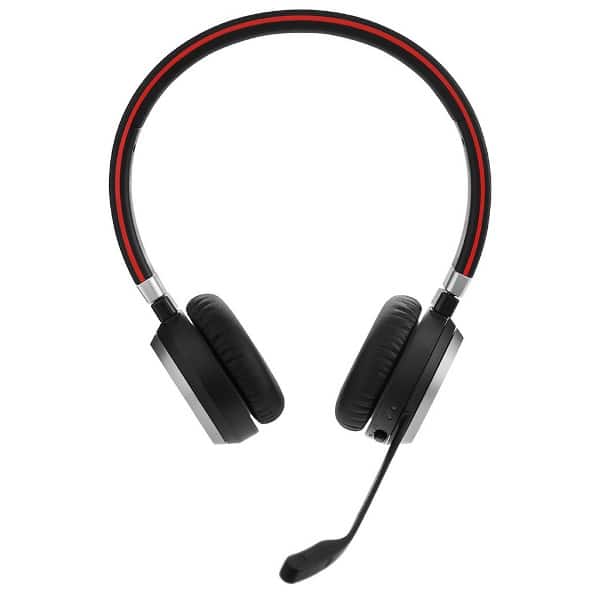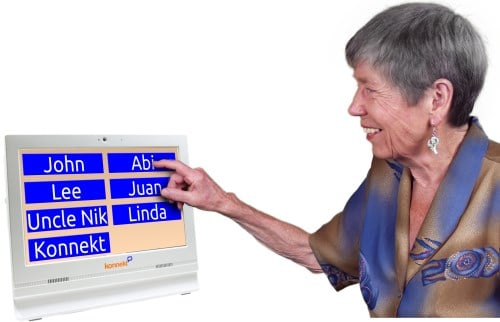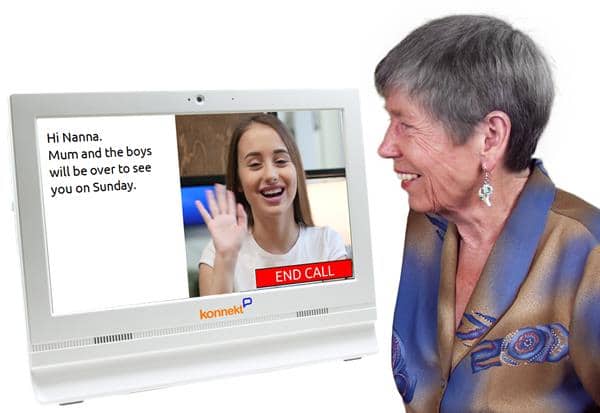Alternatives to a CapTel phone or a Teletypewriter (TTY) for those with deafness or impaired hearing
The Konnekt Captioning Videophone is an incredibly easy-to-use captioning phone. It captions both standard phone calls as well as video calls, enabling you to read lips and facial expressions.
Speech-to-text phone calls have never been easier.
Click to read about the Konnekt Captioning Videophone.
Captioning phone alternatives
From 1 February 2020, Captel phones were no longer connected to the National Relay Service — read why in the Statement to the House. Many rely on captioning phones to communicate with the outside world including their doctors, pharmacists, family, friends, colleagues, customers and care-givers. There is a need to migrate to alternatives, such as the Konnekt phone.
How CapTel captioning used to work
The CapTel® captioning phone worked in a similar way to a regular phone but added live captioning, sometimes known as transcription, subtitles, or voice-to-text.
To call a friend from your phone, you would first press a Captions button to enable captioning, then dial your friend’s number. The phone would connect you to your friend so that you could talk, just like using a traditional phone.
The phone would also connect you to the domestic captioning service, via the Internet. The captioning service would transcribe your friend’s voice into text, using a human relay officer, sometimes called a relay agent. The officer would re-read what he thought he heard into a computer (adding a delay) and then, using his keyboard, the officer would attempt to correct anything that was mis-heard or mis-captioned (adding another delay). The text was sent to your phone via your Internet connection, and appeared on a small screen built into the phone. This enabled you to read what the other person was saying.
The captioning service is run by the National Relay Service (NRS). NRS is a government initiative that offers a wide variety of services to help people who have hearing and/or speech impairments to make and receive calls.
In Feb 2020, the phones in Australia were temporarily connected to a US captioning centre, providing additional time for users to transition to alternatives. The temporary voice connection across the globe, plus the return trip for the captions, would add another 0.5-1.0 seconds to the captioning latency, slowing down what you see on the screen.
Strengths
- Direct dial: You dialed the phone number of the person you wanted to call, and vice-versa. There was no need for you or your callers to call the relay officer (as is the case with some other systems such as the Teletypewriter, also known as TTY).
- Accuracy: Captions were delayed but were usually quite accurate, due to the use of a trained Australian human relay officer, as long as the speech was not too fast.
- Emergency service: The user could pick up the handset, press the Captions button if required, and dial 000. Some TTY systems require a separate phone number and/or a 9-step procedure.
Shortcomings
- Lack of privacy: A relay officer would listen in to your phone calls.
- No video: The Captel phone does not allow video calling, so there was no ability to lip-read, perceive facial expressions, interpret emotional cues, use sign language, show objects or share screens. Video calling could otherwise augment captioning to provide a richer, multi-mode experience, and help reduce social isolation.
- Missed calls: If the phone would ring while you were in another room, you might have missed the call.
Teletypewriters are slower, smaller, harder to use, risky in emergencies
Teletypewriter (TTY) systems can be:
- Slow: The user must first make contact with a relay officer to arrange their call.
- Hard to read: The screen is much smaller, not as bright, and shows less text (1-2 lines), making it difficult for those with low vision, slow readers, and those who might misplace their glasses during an emergency.
- Difficult to use: The TTY needs many more steps and requires re-learning — making it difficult for some older adults and those with poor dexterity or poor memory.
- Risky in emergencies: There is a nine-step card that shows how to call emergency services. A different phone number is used. During an emergency, the user may forget the nine steps, the number, or fail to locate the card.
Internet-browser alternatives can be hard to use, require a new device
There are Internet browser-based captioning relay apps and services:
- New device: A computer or tablet is required. It must be left on all the time so that incoming calls are not missed.
- Potentially complicated: The browser-based services require registration, login, and multiple steps to make a call or prepare to receive a call. For many, they can be complicated and difficult to use.
- Operator: Your caller cannot simply call you directly. The caller must call an operator and enter more digits thereafter. Many callers (such as businesses) simply may not bother to call you back.
- Employers at risk: Those who work need a solution for office and home. Employers need a solution to avoid potential legal action for workplace discrimination. A business phone cannot be diverted to a system that requires an operator to be dialed.
Introducing Skype: A modern solution to captioning

Skype with captioning
- Phone calls and video calls: Read lips, share screens, use sign language
- Any device: Works on a mobile, iPad/tablet or PC/Mac
- Private: Automatic transcription; no humans listening
- Learn it: Suits those who are able to learn a new app
- Uses Internet: No active phone service is required
Watch and follow: Set up Skype captioning
How to set up Skype captioning
- Download Skype: Get the Skype app from skype.com or your device’s app store. It’s free to download.
- Start Skype: At the top of the Chats screen, tap the circle containing your own initials or photo. Scroll down. Open Settings.
- Settings: In Settings, tap on Calling, located midway down on the left of the screen.
- Calling Settings: In Calling Settings, tap on Call subtitles.
- Subtitles: Turn on Show subtitles for all calls. Captioning starts automatically for both voice and video calls.
Problems? Contact Konnekt by phone or online chat. We’ll walk you through it.
Frequently Asked Questions
Yes.
- Free: Skype-to-Skype calls are free. No subscription is required. An active phone service is not needed.
- Internet: Skype uses Internet (fixed or mobile), is NBN-compatible, and uses only a little Internet data.
- Skype app: Persuade family and friends to get Skype onto their devices, so you can call them for free.
Unlike other video chat apps (such as FaceTime, WhatsApp or Facebook Messenger), Skype provides captioning. Skype works practically anywhere, worldwide.
Yes. With Skype, you can also call regular phone numbers:
- Call older friends that have no Smartphone, tablet or computer, or don’t want to use Skype
- Call your service providers, medical professionals, shops, or anyone worldwide
You will need a little Skype credit and/or a Skype subscription.
Skype credit
If you are just trying out Skype, you might like to start by purchasing a little Skype credit. You can control how much Skype credit you buy, and you can top it up just when you need to. The Skype call rates are quite good value, but keep in mind that all calls are timed — even local calls. So Skype credit is best suited to those who only make short phone calls and don’t make them very often.
One advantage of Skype credit is that you can call practically any telephone in Australia and overseas, including Australian 13 and 1300 numbers.
If you find yourself running out of Skype credit often because you’re a big talker, a Skype subscription might suit you better.
Skype subscriptions
If you plan to use Skype for all or most of your calls to regular fixed-line telephones (landlines) in Australia, we recommend getting a Skype subscription for unlimited calls to Australian landlines. You’ll have a fixed amount to pay each month. No surprises. You can call any landline in Australia, including 1800 free-call numbers, but not 13 or 1300 numbers.
What about calls to mobiles?
If you only call mobile phones occasionally, then you might like to purchase a little Skype credit and top it up when you need to. If you call mobile phone numbers frequently, you can either:
- Convince your friends to put Skype on their mobile phones, so that you can call them Skype-to-Skype for free;
- Get a Skype subscription for 100 minutes or 300 minutes of calls to Australian landlines and mobiles (note that you can have more than one Skype subscription);
- Get a Skype subscription for unlimited calls to Australian landlines and mobiles.
Find out more about Skype credit, Skype call rates and Skype subscriptions here.
Calls to emergency services are free
In Australia, UK and several other countries, you can make emergency calls from Skype.
- Simply dial 000 from within the Skype app.
- If configured, Skype captioning will start automatically during your emergency call.
When you call 000 from a regular phone, the emergency services operator can look up your home address. If you have a genuine emergency but you are unable to tell the emergency services operator your address, they can still send an ambulance (or police or fire services) to your home, if required. What if you use Skype?
- Skype on a computer: If you are running Skype on a Windows, Mac or Linux computer, we understand that the emergency services operator can access the address against which your Skype account is registered.
- Skype on a mobile: If you are running Skype on your mobile phone or an iPad/tablet containing an active SIM card, then as we understand it, your emergency call will be initiated through your device’s native dial pad and the mobile network. The emergency services operator can access the address against which your mobile phone service is registered.
Yes. To receive incoming calls from regular landline telephones, you need to have a telephone number that people can dial. If you use Skype, you can get a Skype Number.
Skype Numbers
A Skype Number is a regular telephone number that connects incoming calls to your Skype service. You can get a Skype Number in Australia that starts with 02, 03, 07 or 08.
- Rings or vibrates your Skype devices: When people call your Skype Number, it will ring on all your devices that have Skype installed (such as your Smartphone, iPad/tablet and computer). If you have poor hearing, you can set it to vibrate your phone or tablet when there’s an incoming call.
- Local numbers for other countries: You can even get Skype Numbers for other countries. This is helpful if (for example) you live in Australia but most of your friends and family are in the US or UK. That way, they can call you from their regular landline and mobile telephones for the cost of a domestic call.
- Multiple numbers: If you want, you can have more than one Skype Number.
- Fixed monthly cost: A Skype Number costs less than $10 per month. If you want, you can pay a little less by paying per quarter (every 3 months) or year. There are no usage costs associated with having a Skype Number. You pay the same amount for your Skype Number no matter how many times people call you.
Find out more about Skype Numbers here.
Call Forwarding
What if your friends call your old home or mobile number?
Take the call on Skype: You can call-forward (divert) the telephone number of your existing mobile phone service and/or your existing landline phone service to your Skype Number if you wish. This is especially handy if you install Skype on your mobile phone and you go out often, but your friends are used to calling you on your home phone. When they call your mobile or landline phone number, it will ring on your Skype so that when you answer, you’ll have captions.
Call-forwarding costs: Note that call forwarding may bear a cost to your existing phone service, (depending on your phone plan), for each incoming call that is forwarded to your Skype Number. However, if your existing phone service has an unlimited domestic-calls plan (so that your calls to Australian fixed phone numbers are normally free), then most likely there will be no incremental cost for your forwarded incoming calls. If in doubt, check with your existing phone service provider.
How to set call forwarding: To call-forward your existing mobile or landline phone service to your Skype Number, contact your phone service provider or ask us. Or if you’re feeling brave, try these call-forwarding codes to set up call forwarding automatically. In Australia:
- For Telstra fixed phone services (landlines): Pick up the phone, listen for a dial tone, dial *2 1, enter your Skype Number, press # and hang up.
- For Optus fixed phone services: Pick up the phone, listen for a dial tone, dial *7 8, enter your Skype Number, wait for two short beeps, hang up.
- For all mobile phone services: Go to Phone Settings or Call Settings on your mobile phone, or read on for another way.
- For Telstra mobile phone services: Dial * * 2 1 *, your Skype Number, * 1 0 #, then press Send or Call.
- For Optus and Vodafone mobile phone services: Dial * * 21 *, your Skype Number, #, then press Send or Call.
Of course, once your friends and family have learned your Skype Number, you may wish to entirely cancel your existing phone service.
Konnekt can help you to improve Skype quality, or you can read our Skype Quality Guide. Here are the key factors.
Reduce noise: Both the caller and receiver need to be located in a room with minimal background noise. This includes turning off TVs and closing windows. If you are outside, try to find a quiet place where there is no wind.
Great Wi-Fi: Ensure that both of you have a very strong Wi-Fi signal, or a strong mobile signal if you are using mobile Internet. This will make the calls clearer both visually and audibly.
Headset or earphones: Both parties should invest in a quality headset or earphones with a microphone. Alternatively, the earbuds or earphones provided with your mobile phone generally include a microphone at about chin level, built into the cable. Note that most computers require a headset with two 3.5mm plugs (one for speaker and one for microphone). Older Smartphones use a single 3.5mm socket. Some newer Smartphones (including all new iPhones) use a proprietary or newer connector.
The simplest solution is to use the earbuds or earphones that came with your device, or else take your device to a computer shop or mobile phone shop.
This single step can make an enormous difference!
Volume: If you have total deafness, reduce the volume to zero or mute your speaker. Otherwise, set volume to a comfortable level; not too loud.
Clear speech: Ask your friend to speak slowly, clearly and distinctly. If they speak with a strong accent, suggest that they leave gaps between words. Don’t be afraid to ask them to repeat or paraphrase a sentence.
Automatic speech: If you have trouble being understood, a typing-to-voice communicator, also known as a talking keyboard, may be beneficial. If you already have a device that you’re used to typing on, get an AAC app for your PC / tablet / mobile phone. A conventional typing-to-voice communication device can be very expensive but may be easier to use than a free app on a tablet or mobile. The TextSpeak costs about US $500 – $600 and is available here.
Reliable Internet is vital. If you are having difficulties with your internet, Konnekt can recommend or help you with a low-cost, high-reliability provider in many countries. Within Australia, Konnekt can help set it up and manage it for you.

Headsets for captioned calls
Use a good-quality headset, or at least the earbuds that came with your device, which should have a tiny microphone built-in to the cable at around chin level. This will:
- attenuate external noise
- increase sound quality
- reduce echo-suppression artefacts
- improve captioning accuracy
What about an easier solution?

Konnekt Videophone for the hearing impaired
- Incredibly easy: One touch to call; large 15-inch screen
- Phone calls and video calls: Read lips and faces
- Loud; SUPER loud with our optional powered speaker
- Hearing-aid compatible
Konnekt Videophone with automatic captioning
- Far easier than regular captioned phones, teletypewriters (TTY)
- Much easier than voice-to-text apps or speech-to-text services
- Very much easier than mobile phones, tablets or computers
- Captions start automatically; no registration, no logins, no buttons
- Optional: Captioned video calls – do you subconciously read lips?
Konnekt Captioning Videophone
- Fast, large, accurate captioning on phone calls and video calls
- Regular phone calls: Call regular phones, too (including landlines)
- When it rings: Turn on lamps, vibrate a pocket device
- Government funding: MyAgedCare and NDIS
Government funding may pay for your Konnekt
If you have deafness, hearing loss or a hearing impairment, or if you are hard-of-hearing or wear hearing aids or a hearing implant, you may qualify. Act now!
Learn about government funding.

